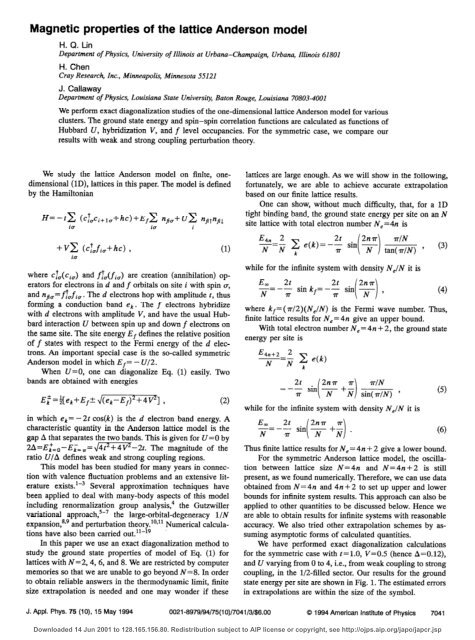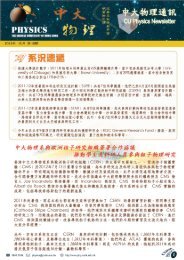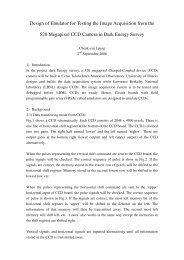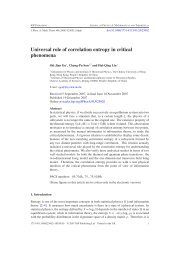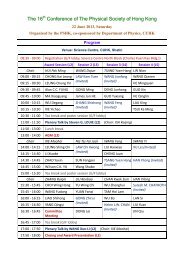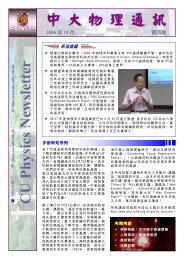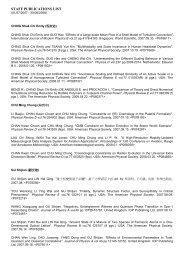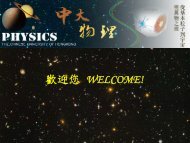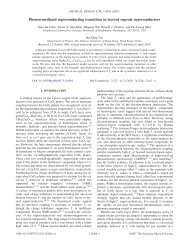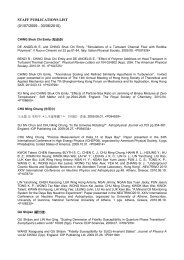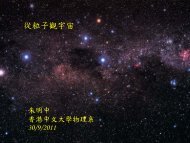Magnetic properties of the lattice Anderson model - Department of ...
Magnetic properties of the lattice Anderson model - Department of ...
Magnetic properties of the lattice Anderson model - Department of ...
You also want an ePaper? Increase the reach of your titles
YUMPU automatically turns print PDFs into web optimized ePapers that Google loves.
<strong>Magnetic</strong> <strong>properties</strong> <strong>of</strong> <strong>the</strong> <strong>lattice</strong> <strong>Anderson</strong> <strong>model</strong><br />
H. Q. tin<br />
<strong>Department</strong> <strong>of</strong> Physics, University <strong>of</strong> Illinois at Urbana-Champaign, Urbana, Illinois 61801<br />
H. Chen<br />
Cray Research, Inc., Minneapolis, Minnesota 55121<br />
J. Callaway<br />
<strong>Department</strong> <strong>of</strong> Physics, Louisiana State University, Baton Rouge, Louisiana 70803-4001<br />
We perform exact diagonalization studies <strong>of</strong> <strong>the</strong> one-dimensional <strong>lattice</strong> <strong>Anderson</strong> <strong>model</strong> for various<br />
clusters. The ground state energy and spin-spin correlation functions are calculated as functions <strong>of</strong><br />
Hubbard U, hybridization V, and f level occupancies. For <strong>the</strong> symmetric case, we compare our<br />
results with weak and strong coupling perturbation <strong>the</strong>ory.<br />
We study <strong>the</strong> <strong>lattice</strong> <strong>Anderson</strong> <strong>model</strong> on finite, onedimensional<br />
(lD), <strong>lattice</strong>s in this paper. The <strong>model</strong> is defined<br />
by <strong>the</strong> Hamiltonian<br />
H=-tC (c~&+,,+hc)+EfC ntia+uC rlfiplfil<br />
io ia i<br />
+vC (cTJic+hc) P (1)<br />
ia<br />
where ci&ci,) and fio(fi,) are creation (annihilation) operators<br />
for electrons in d and f orbitals on site i with spin a;<br />
and npg=ficfiw. The d electrons hop with amplitude t, thus<br />
forming a conduction band ek. The f electrons hybridize<br />
with d electrons with amplitude V, and have <strong>the</strong> usual Hubbard<br />
interaction U between spin up and down f electrons on<br />
<strong>the</strong> same site. The site energy E, defines <strong>the</strong> relative position<br />
<strong>of</strong> f states with respect to <strong>the</strong> Fermi energy <strong>of</strong> <strong>the</strong> d electrons.<br />
An important special case is <strong>the</strong> so-called symmetric<br />
<strong>Anderson</strong> <strong>model</strong> in which Ef= - U/2.<br />
When U=O, one can diagonalize Eq. (1) easily. Two<br />
bands are obtained with energies<br />
Ei=gek+Ef+. \I(ek-E,)2+4vZ] , (2)<br />
in which ek = - 2t cos(k) is <strong>the</strong> d electron band energy. A<br />
characteristic quantity in <strong>the</strong> <strong>Anderson</strong> <strong>lattice</strong> <strong>model</strong> is <strong>the</strong><br />
gap A that separates <strong>the</strong> two bands. This is given for U=O by<br />
2A=E&,-Ei= ,r= dm’-2t. The magnitude <strong>of</strong> <strong>the</strong><br />
ratio U/A defines weak and strong coupling regions.<br />
This <strong>model</strong> has been studied for many years in connection<br />
with valence fluctuation problems and an extensive literature<br />
exists.lm3 Several approximation techniques have<br />
been applied to deal with many-body aspects <strong>of</strong> this <strong>model</strong><br />
including renormalization group analysis,4 <strong>the</strong> Gutzwiller<br />
variational approach,5-7 <strong>the</strong> large-orbital-degeneracy l/N<br />
expansion,‘p9 and perturbation <strong>the</strong>ory.“‘” Numerical calculations<br />
have also been carried out.11-r9<br />
In this paper we use an exact diagonalization method to<br />
study <strong>the</strong> ground state <strong>properties</strong> <strong>of</strong> <strong>model</strong> <strong>of</strong> Eq. (1) for<br />
<strong>lattice</strong>s with N =2,4, 6, and 8. We are restricted by computer<br />
memories so that we are unable to go beyond N=8. In order<br />
to obtain reliable answers in <strong>the</strong> <strong>the</strong>rmodynamic limit, finite<br />
size extrapolation is needed and one may wonder if <strong>the</strong>se<br />
<strong>lattice</strong>s are large enough. As we will show in <strong>the</strong> following,<br />
fortunately, we are able to achieve accurate extrapolation<br />
based on our finite <strong>lattice</strong> results.<br />
One can show, without much difficulty, that, for a 1D<br />
tight binding band, <strong>the</strong> ground state energy per site on an N<br />
site <strong>lattice</strong> with total electron number N,=4n is<br />
$=i q e(k) = -G sinj T) tanzNj ,<br />
while for <strong>the</strong> infinite system with density NJN<br />
E, 2t 2t 2nrr<br />
-=-; sin kf=-- sin -<br />
N<br />
T ( N i ’<br />
it is<br />
where kf= (7r/2)(N,/N) is <strong>the</strong> Fermi wave number. Thus,<br />
finite <strong>lattice</strong> results for N, = 4n give an upper bound.<br />
With total electron number N, = 4n + 2, <strong>the</strong> ground state<br />
energy per site is<br />
E4n+2 2<br />
-=- 2 e(k)<br />
N N,<br />
2t 2nrr n- TIN<br />
=-- sin -<br />
T i N +z i sin(r/N) ’<br />
while for <strong>the</strong> infinite system with density N,IN<br />
E, 2t 2n7r 7r<br />
x=-T sin F+g .<br />
i<br />
i<br />
it is<br />
Thus finite <strong>lattice</strong> results for N, = 4n + 2 give a lower bound.<br />
For <strong>the</strong> symmetric <strong>Anderson</strong> <strong>lattice</strong> <strong>model</strong>, <strong>the</strong> oscillation<br />
between <strong>lattice</strong> size N= 4n and N=4n + 2 is still<br />
present, as we found numerically. Therefore, we can use data<br />
obtained from N= 4n and 4n + 2 to set up upper and lower<br />
bounds for infinite system results. This approach can also be<br />
applied to o<strong>the</strong>r quantities to be discussed below. Hence we<br />
are able to obtain results for infinite systems with reasonable<br />
accuracy. We also tried o<strong>the</strong>r extrapolation schemes by assuming<br />
asymptotic forms <strong>of</strong> calculated quantities.<br />
We have performed exact diagonalization calculations<br />
for <strong>the</strong> symmetric case with t=l.O, V=OS (hence A=O.12),<br />
and U varying from 0 to 4, i.e., from weak coupling to strong<br />
coupling, in <strong>the</strong> l/2-filled sector. Our results for <strong>the</strong> ground<br />
state energy per site are shown in Fig. 1. The estimated errors<br />
in extrapolations are within <strong>the</strong> size <strong>of</strong> <strong>the</strong> symbol.<br />
(3)<br />
(4)<br />
(5)<br />
(6)<br />
J. Appl. Phys. 75 (lo), 15 May 1994 0021-8979/94/75(10)/7041/3/$8.00 0 1994 American institute <strong>of</strong> Physics 7041<br />
Downloaded 14 Jun 2001 to 128.165.156.80. Redistribution subject to AIP license or copyright, see http://ojps.aip.org/japo/japcr.jsp
FIG. 1. The ground state energy per site as function <strong>of</strong> U for <strong>the</strong> symmetric FIG. 2. Square <strong>of</strong> <strong>the</strong> f orbital local moment as function <strong>of</strong> U for <strong>the</strong> same<br />
<strong>Anderson</strong> <strong>lattice</strong> <strong>model</strong> with r=l, V=OS. The dashed line is <strong>the</strong> weak case as in Fig. 1.<br />
coupling perturbation result from Eq. (7), and <strong>the</strong> solid line is <strong>the</strong> strong<br />
coupling perturbation result from Eq. (9). The squares are <strong>the</strong> exact diagonalixation<br />
results and <strong>the</strong> uncertainties in <strong>the</strong> infinite system extrapolation<br />
are within <strong>the</strong> size <strong>of</strong> <strong>the</strong> symbol. 2-1<br />
mfz-2<br />
4u<br />
+JqT (12)<br />
According to perturbation <strong>the</strong>ory,““’ for <strong>the</strong> symmetric<br />
case in <strong>the</strong> weak coupling limit where U/A is small, <strong>the</strong><br />
ground state energy per site is<br />
with<br />
E(U)=; 2 E;-;<br />
k<br />
-N3<br />
U2<br />
ui=$l+ei/(ei+4V2)1’2] ,<br />
vi=gl-ei/(ei+4V2)“2] .<br />
In <strong>the</strong> strong coupling limit where U/A is large, <strong>the</strong> ground<br />
state energy per site is<br />
E(U)=-; +; c e&e,,-? T ;;;:;j 7<br />
k<br />
(10)<br />
with f(ek) being <strong>the</strong> zero temperature Fermi factor.<br />
We show weak coupling results as <strong>the</strong> dashed line and<br />
strong coupling results as <strong>the</strong> solid line in Fig. 1. Note that<br />
<strong>the</strong>re is a singularity in strong coupling limit as ZJ+O<br />
[roughly In(U)] but it is hard to see from Fig. 1.<br />
As U increases from 0 to ~0, electrons tend to localize in<br />
<strong>the</strong> f orbitals and form local moments. We measure <strong>the</strong>se<br />
moments by m& defined by<br />
4z=((nfT-nf1)2) , (11)<br />
which varies from 1 when U =O, to 1 when U=m.<br />
coupling we have<br />
(7)<br />
(8)<br />
(9)<br />
For weak<br />
while for strong coupling we have<br />
l-f(ek)<br />
m +-q c<br />
k (U/2+ek)’ *<br />
(13)<br />
We show <strong>the</strong>se results as <strong>the</strong> dashed line and solid line in<br />
Fig. 2, along with data points obtained from our exact diagonalization<br />
studies. Again, estimated errors in extrapolations<br />
are within <strong>the</strong> size <strong>of</strong> <strong>the</strong> symbol.<br />
From Fig. 2, it is evident that weak coupling perturbation<br />
is invalid for U/A>8 and strong coupling perturbation<br />
gives bad answers for U/A
0.2<br />
0<br />
,,,I I I I I I1 I I I I* I I I<br />
0 1<br />
z<br />
3 4<br />
FIG. 3. The ratio <strong>of</strong> <strong>the</strong> hybridization matrix element (c!,fi,+hc) to its<br />
lJ=O value as a function <strong>of</strong> U for <strong>the</strong> same case as in Fig. 1.<br />
changes between 1 and 2. (3) The Kondo region, in which<br />
one has nf- 1, n,-1. Its range is roughly -U- t


